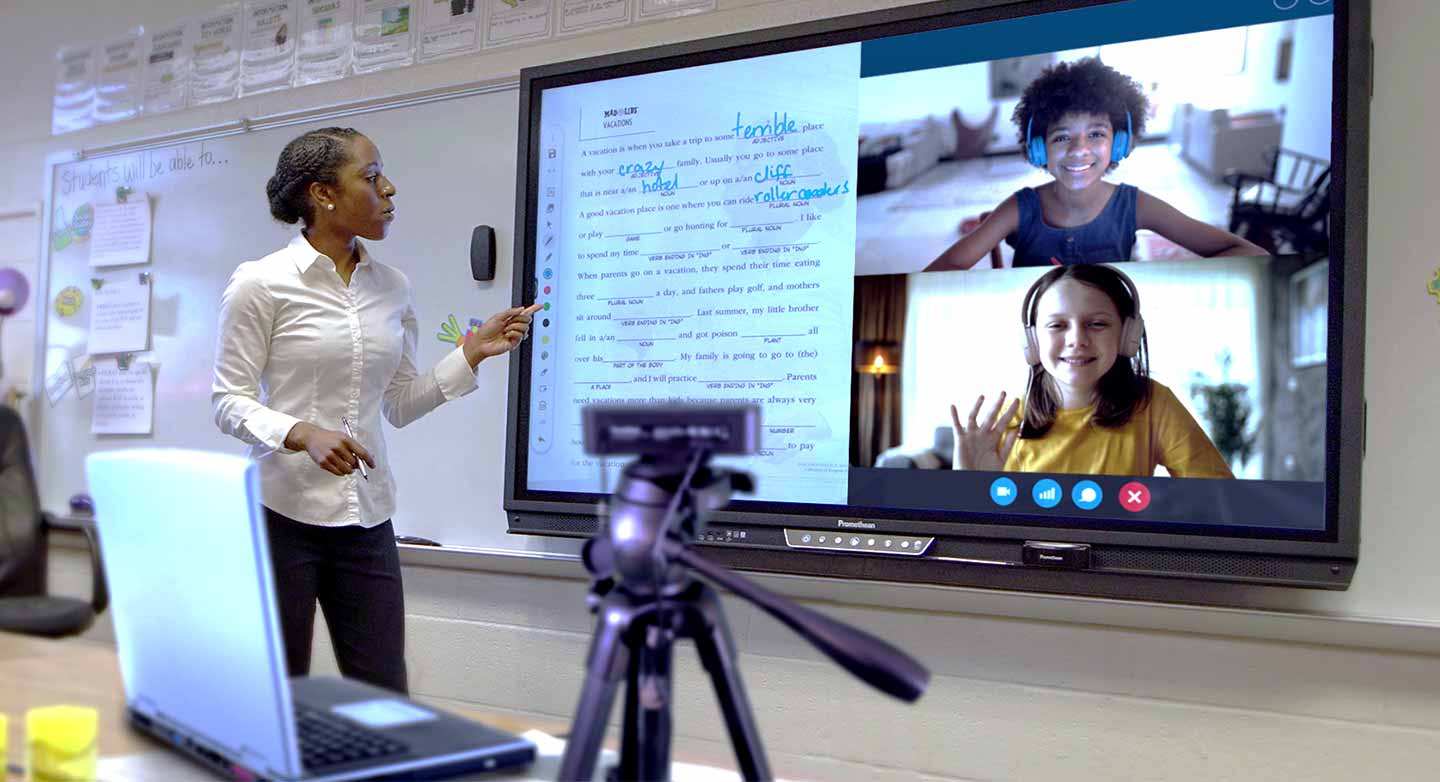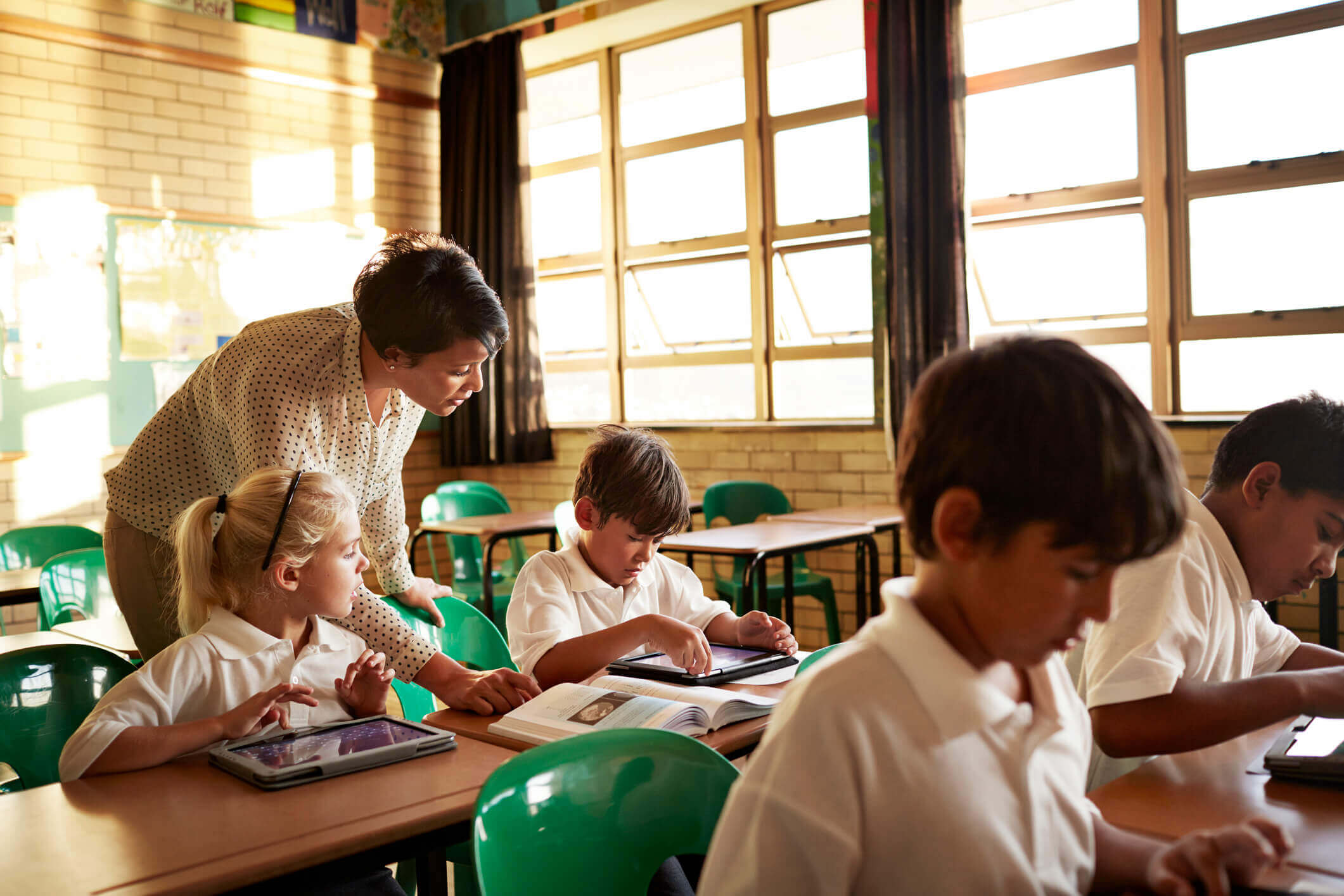Published on November 23rd, 2021
Six blended learning examples and strategies for the classroom
13 minute read

Blending learning is something which has long been talked about as an optimal learning strategy. While it was already popular, there was a shift during 2020’s pandemic that meant blended learning became even more pivotal. While the effectiveness of blended learning has been widely covered, many find it difficult to define what blended learning is, making it awkward to implement to its full potential.
At Promethean, we’re experts in classroom technology and e-learning, which puts us in a unique position to help you understand exactly what blended learning is and provide a number of blended learning strategies for your classroom. We’ve put together the ultimate guide to blended learning to help you do just that.
What is blended learning?
Blended learning, in short, is the combination of face to face lessons with classroom technology and elearning.
It allows students to receive the very best face to face teaching, while benefiting from additional resources, support and technology which can aid people with different learning styles absorb information more effectively. The physical teaching aspect of blended learning could take place via webinars, video conferencing or in a good old fashioned physical classroom, but having this physical element at the core of your strategy is key to keeping it blended.
The benefits of introducing blended learning models to your classroom
On paper that sounds great, but it also sounds like a lot to take on board. It’s not just students who benefit from blended learning, there are a number of positives for teachers and the organisations they work for too.
Blended learning benefits for students
For students, the benefits are manifold. Not only does blended learning make a course more accessible for those who struggle with classroom-based learning, it lowers costs and makes a new subject more immersive. The benefits of blended learning models for students include:
- Lessons aren’t limited to one learning style – while many students find a teacher talking through a theory useful, it’s not the most effective way for a large number of students to learn. Blended learning allows students to mix up how they learn, and for teachers to set a mixture of tasks aimed at the main learning styles. Technology allows for gamification and empowers group projects. It also provides students with access to learning materials out of core teaching hours too, so can let them learn at their own pace.
- Improves both accessibility & flexibility – many students, of all ages, find attending classes can be difficult. A blended learning model allows students to learn in much more flexible ways. Lessons can be replaced with webinars or videos, and other key aspects can be done online. Taking away the requirement for face to face lessons lowers the barriers many students face. It can help students who struggle with the classroom environment, those who may not be able to attend classes or those who need to structure their learning around work or care.
- Keep costs lower – when you aren’t tied to a classroom and part, or all, of a lesson can be delivered online, either pre-recorded or via other means, costs can be kept much lower. This means students are much more likely to be able to afford to attend and learn.
- Encourages social learning – blended learning can encourage students to learn much more socially. They can reach out to teachers or fellow learners to improve their learning outcomes.
Blended learning benefits for teachers
- Personalise lessons for students – using technology and other e-learning methods allows teachers to change up how they plan lessons. There are many benefits of technology in the classroom and one of these is opening up new teaching methods. Teachers can set tasks for different learning styles, whether that’s videos for visual learners, group tasks for social learners or adding gamification for a number of different styles.
- Track progression – teachers can track progress. By showing how far along on a piece of work a student is, or by creating online quizzes and tests to test a student’s knowledge on a subject.
- Plan lessons fluidly – as blended learning uses both online and offline teaching together, lesson plans can be created that allow for each. Some subjects may be easier for students to learn from online resources whereas others may be easier for a teacher to demonstrate in class.
6 blended learning strategies for your classroom
There are so many different ways you can apply blended learning strategies. You may, in fact, be doing it already. As blended learning essentially comes down to a mixture of face to face learning and online studying, there’s a strong chance you’re already using a very basic blended learning model just through normal lessons and the homework assignments you’re setting.
We’re going to run through a number of different blended learning methods to help you take it even further, so you can improve the learning outcomes of your students.
1. Rotation blended learning
There are a number of different types of rotation blended learning. These include ‘station’, ‘remote’ and ‘flipped’ learning. The core element of rotation learning is that students will move from one type of learning to another on a fixed schedule.
Station & Lab
For station rotation, students will be given a fixed schedule where they work through different stations on rotation. This is very similar to how many schools operate in a more traditional method. There will be fixed classes and other aspects which can be fixed in terms of online learning. It’ll include lessons, assignments, tutoring, group discussions or small group instruction.
Lab learning is another form of this, but one of the stations will include time in computer labs or organised e-learning environments.
Remote
This is a less structured approach and may not use such a fixed schedule, but it’s still designed to rotate between teaching methods. For remote rotation though, the focus is on learning through assignments, online coursework or other remote friendly methods and only attending face to face lessons or meetings occasionally.
Flipped learning
Flipped learning is a little different to remote learning, but many talk about them in a similar way. For flipped learning the teacher will assign work and reading that’s essential to the understanding of the physical classes being taught. This may mean you have to read something or complete an assignment before a class to understand what’s about to be taught, but it can also include completing online work afterwards.
2. Flexible or self-directed blended learning
Flex learning is a learning method often used for older students, those on training or corporate learning. Students are provided with access to a centralised curriculum but then given the flexibility to learn it how they see fit, at their own pace and in their own time. While this may not sound like a blended learning approach, flex learning usually provides teachers for mentoring support or at key points to answer questions.
Flex learning is often referred to as personalised learning or self-directed learning.
3. Gamification
While gamification isn’t a strategy on its own, it’s an excellent way to improve your blended learning experience. Gamification uses technology, whether it’s interactive whiteboards or an online learning platform, to help students learn new skills. This could be as simple as a fun quiz on a subject you’re teaching or something more interactive that requires learners to earn points or increase levels. For many, gamification improves the absorption of information and helps them push themselves to learn course content.
4. Self-blend & supplemental learning
A self-blend, or supplemental blended learning method is a little different to a flexible or self-directed method. In those instances, the student is learning something key to the course, whereas a self-blend approach is generally supplementary. Generally, a student using self-blend learning will opt to take online courses, do extra reading or additional assignments that are completely supplementary to the work being set by their teacher. This additional learning can give them a better understanding of what they’re being taught, but it’s not essential to passing the course.
5. Project-based blended learning
Project-based learning is a learning style that’s completely separate to blended learning, but combining the two can be highly effective. Project-based learning relies on immersing learners in one particular project, whether it’s a question or challenge, and focusing on solving that one problem over a period of time. Often these challenges are either purely face to face or entirely assignment based. Using a blended approach allows students to push themselves even further.
6. Outside-in blended learning
The outside-in approach relies on remote and virtual learning up front, followed by bringing everything together in a physical classroom at the end. Students will learn via online training, assignments and coursework in a structured fashion, then the classroom will be used as a finishing point to tie together their own learning, encourage collaboration and provide feedback.
Get the most out of your class with interactive whiteboards and software
Whatever way you want to teach your students, keeping them involved in the process is important. When your students come to a classroom and feel like an active participant, it’s only going to help. Promethean creates world leading interactive displays designed with the classroom in mind. Not only that, but we set the standard on educational software to help you get the most out of your smart technology.
Interested in learning more? Visit the virtual demo page to request a live demo of the Promethean ActivPanel interactive display.




